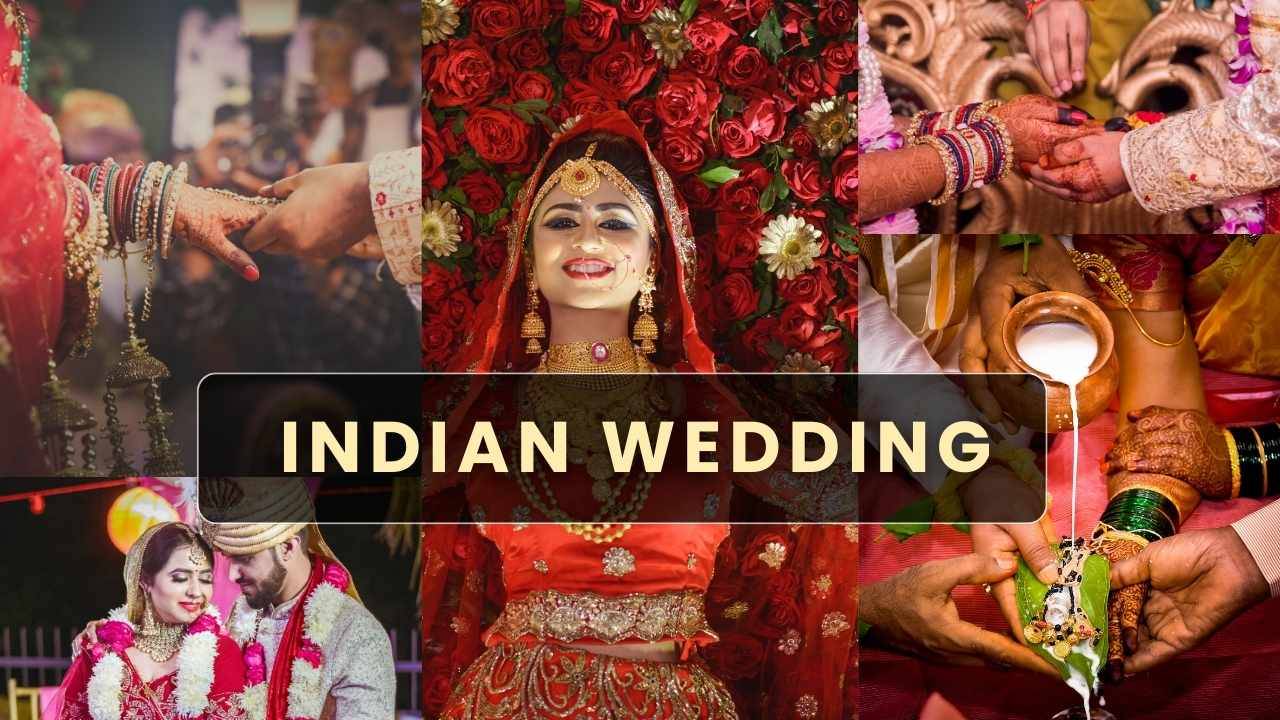Indian weddings are known for their grandeur, vibrant colors, and rich cultural traditions. They are a beautiful blend of rituals and celebrations that span over several days, making them an unforgettable experience for the bride, groom, and their families. In this blog, we’ll provide you with a comprehensive list of marriage functions that typically take place during an Indian wedding, highlighting the significance and beauty of each event. Indian Wedding Functions
List of Indian Wedding Functions
- Roka or Sagai (Engagement Ceremony):
The Roka or Sagai ceremony marks the beginning of the wedding journey. It is an official announcement of the couple’s intention to marry, where both families exchange gifts, sweets, and blessings. The bride and groom exchange rings in the presence of close friends and family members, signifying their commitment to each other.

- Haldi (Turmeric Ceremony):
The Haldi ceremony is a pre-wedding ritual held at both the bride and groom’s homes. A paste of turmeric, sandalwood, and rosewater is applied to the couple’s face, hands, and feet by family members and close friends. This ceremony is believed to bring good luck and ward off evil spirits while also beautifying the couple for their big day.

- Mehendi (Henna Ceremony):
The Mehendi ceremony is an essential part of Indian weddings, where the bride’s hands and feet are adorned with intricate henna designs. This event is often accompanied by music, dance, and laughter, as the bride’s family and friends come together to celebrate her upcoming nuptials.

- Sangeet (Music and Dance Night):
The Sangeet ceremony is a lively event filled with music, dance, and entertainment. It is an occasion for both families to come together, showcasing their talents and enjoying themselves. The atmosphere is festive, with everyone dancing and singing to popular Bollywood tunes and traditional folk songs.

- Baraat (Groom’s Procession):
The Baraat is a vibrant and lively procession that marks the groom’s arrival at the wedding venue. The groom, accompanied by his family and friends, dances his way towards the bride’s house or wedding venue. The groom usually arrives on a decorated horse or in a luxury car, while his entourage dances and celebrates around him.

- Jaimala (Garland Exchange Ceremony):
The Jaimala ceremony is a beautiful moment where the bride and groom exchange garlands made of fresh flowers. This ritual signifies their acceptance of each other and the union of their families.

- Kanyadaan (Giving Away the Bride):
During the Kanyadaan ceremony, the bride’s father gives his daughter’s hand in marriage to the groom. This symbolic gesture represents the transfer of responsibility and care from the bride’s family to the groom and his family.

- Phere (Circling the Holy Fire):
The Phere is an essential part of the Indian wedding ceremony, where the bride and groom circle the holy fire seven times. Each round represents a vow they make to each other, promising love, loyalty, and commitment in their marriage.

- Sindoor Daan (Applying Vermilion):
The groom applies sindoor (vermilion) to the bride’s hair parting, signifying her status as a married woman. This ritual is a vital part of Hindu weddings, symbolizing the groom’s promise to protect and care for his wife.

- Mangalsutra (Sacred Wedding Necklace):
The Mangalsutra ceremony involves the groom tying a sacred necklace around the bride’s neck. This necklace, made of black and gold beads, is believed to protect the couple from evil and symbolizes their eternal bond.

- Saptapadi (Seven Steps):
The Saptapadi is a crucial part of the wedding ceremony, where the bride and groom take seven steps together around the holy fire. Each step represents a vow they make for a happy and prosperous marriage, covering aspects such as health, wealth, love, and spiritual growth.

- Bidaai (Farewell to the Bride):
The Bidaai ceremony marks the bride’s departure from her family home as she leaves with her husband. It is an emotional event, filled with tears and heartfelt goodbyes, as the bride’s family blesses her for a happy married life.

- Griha Pravesh (Welcome to the Groom’s Home):
The Griha Pravesh ceremony marks the bride’s arrival at her new home. The groom’s family welcomes her with traditional rituals, symbolizing her acceptance into their family.

- Reception Party:
The reception party is a grand celebration hosted by the groom’s family to introduce the newlyweds to their extended family and friends. It is a fun-filled event with food, music, and dance, celebrating the couple’s new journey together.

Indian weddings are a beautiful amalgamation of customs, traditions, and celebrations, each function carrying its significance and charm. From the pre-wedding ceremonies to the post-wedding festivities, every event is a testament to the love, joy, and unity that embodies an Indian marriage. So, if you’re planning an Indian wedding, this comprehensive list of marriage functions will help you ensure that your big day is filled with memorable moments and cherished traditions.
